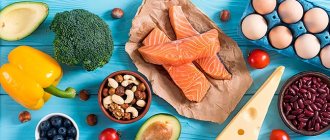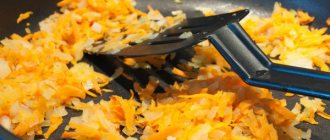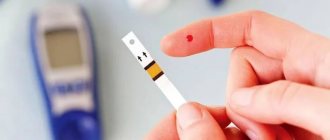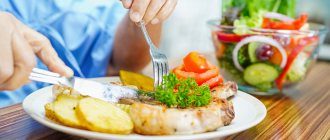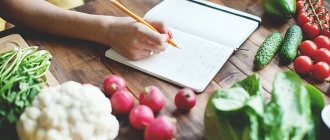Nutrition for diabetes: what can and cannot be eaten? Diabetic menu for the week
Type 2 diabetes mellitus is a complex metabolic disorder based on low tissue sensitivity to insulin. Normally, this pancreatic hormone lowers blood sugar levels.
Insulin promotes the diffusion of glucose into cells. Tissues absorb sugar molecules and use it as energy. Type 2 diabetes mellitus is primarily a disorder of carbohydrate metabolism. But at the same time, other types of metabolism suffer - lipid, protein, mineral.
Proper nutrition for type 2 diabetes is the basis of therapy. If the patient does not adhere to the diet, then no modern drugs can ensure the success of treatment.
Tips for reducing sugar levels
Reducing sugar levels in diabetes mellitus can be achieved through a combination of physical activity, medication and a balanced diet. This balance will help:
- Maintain blood glucose, blood pressure, and cholesterol levels within target ranges;
- lose weight or stay at a healthy weight;
- prevent the development of complications;
- maintain good health and energy 1.
There are general rules for creating a diet to control sugar content:
- Plate rule. Take a plate with a diameter of 23 cm and mentally divide it into 4 equal parts. Half of it should be vegetables (except potatoes, peas and corn), a quarter should be lean proteins, and a quarter should be grains or other starchy foods1
- Minimizing sweetened products: sugary drinks are especially dangerous - lemonade, tea with sugar, industrial fruit juices2
- It is better to use fresh fruits and vegetables as snacks.
- Steam, stew, bake food in its own juice, without adding oil, as it increases the total calorie content3
Table No. 9
Diet No. 9, specially developed for diabetics, is widely used in inpatient treatment of such patients and should be followed at home. It was developed by the Soviet scientist M. Pevzner.
The diet for diabetics includes daily intake of up to:
- 500 ml of fermented milk products, 200 g of low-fat cottage cheese;
- 100 gr. mushrooms;
- 300 gr. fish or meat;
- 80 gr. vegetables;
- 300 gr. fruit;
- 1 glass of natural fruit juice;
- 100-200 gr. rye, wheat mixed with rye flour, bran bread or 200 grams of potatoes, cereals (ready-made);
- 40-60 gr. fat
Main dishes:
- Meat, poultry: veal, rabbit, turkey, chicken, boiled, chopped, stewed.
- Soups: cabbage soup, vegetable soup, borscht, beetroot soup, meat and vegetable okroshka, light meat or fish broth, mushroom broth with vegetables and cereals.
- Appetizers: vinaigrette, mixed fresh vegetables, vegetable caviar, salt-soaked herring, jellied dietary meat and fish, seafood salad with butter, unsalted cheese.
- Fish: low-fat seafood and fish (pike perch, pike, cod, navaga) boiled, steamed, stewed, baked in its own juice.
- Drinks: coffee, weak tea, still mineral water, vegetable and fruit juice, rose hip decoction (without sugar).
- Sweets: desserts made from fresh fruits, berries, fruit jelly without sugar, berry mousses, marmalade and jam without sugar.
- Egg dishes: white omelet, soft-boiled eggs, in dishes.
The difference between diets for type 1 and type 2 diabetes
In type I diabetes, the diet may have the usual calorie content typical for people of similar height and weight. The diet is supportive in nature and is clearly related to how much insulin a person living with diabetes consumes.
Type II diabetes is often accompanied by increased body weight, arterial hypertension, hypercholesterolemia and metabolic syndrome. Therefore, the diet is aimed primarily at reducing body weight. This is manifested in reduced caloric content of food, a decrease in the amount of fat and easily digestible carbohydrates in the diet.
But there are also common points: both groups of people require a complete, balanced diet of proteins, fats and carbohydrates, as well as vitamins, liquids and minerals 2.3.
Cabbage salad with oranges and herbs
We need:
- 2 oranges, large
- 300 g white cabbage
- 1 bunch green basil, small
- 1 bunch of parsley, small
- several green onions
- 3 tbsp. apple or wine vinegar
- 2 tbsp. olive oil
- salt, pepper to taste
Preparation:
1. Shred the cabbage thinly and mash with a pinch of salt.
2. Squeeze 2 tbsp from one orange. juice, peel the second orange and cut into slices.
3. Chop the greens not very finely.
4. Prepare the dressing: mix vinegar, orange juice and olive oil, beat with a fork.
5. In a salad bowl, mix cabbage, orange, herbs and pour dressing. Salt and pepper to taste. serve to the table.
How to reduce the risk of complications with type 1 diabetes
Rules to follow when creating menus 2.3:
- People can consume proteins and fats without restrictions (provided they have normal body weight and take into account calorie content). If you are overweight, it is recommended to limit the fat content in your diet.
- Most vegetables can be eaten with virtually no restrictions. Without counting your sugar levels, you can eat green leafy vegetables, zucchini, peppers, cabbage, and legumes, provided they are consumed in moderation (about 200 g per meal).
- Carbohydrates, which are found in grains (bread), fruits, some vegetables (potatoes, corn), milk and dairy products, and sugar, need to be taken into account. The system of bread units helps you count carbohydrates.
1 more menu option for the week
The menu for the week, despite the skepticism of many people who have just embarked on the path of dietary nutrition, can be very tasty and varied, the main thing is not to make food a priority in life, because it is not the only thing that a person lives by.
Monday:
- The morning begins with milk oatmeal (200 g), a piece of bran bread and a glass of unsweetened black tea.
- Before lunch, have a snack with an apple and drink a glass of tea without sugar.
- For lunch, it is enough to eat a portion of borscht cooked in meat broth, a salad of kohlrabi and apples (100 g), a slice of whole grain bread and wash it all down with a lingonberry drink with a sweetener.
- They have an afternoon snack of lazy dumplings (100 g) and unsweetened rosehip broth.
- Dinner consists of cabbage and meat cutlets (200 g), one soft-boiled chicken egg, rye bread and herbal tea without sweeteners.
- Shortly before bed, drink a glass of fermented baked milk.
Tuesday:
- In the morning, eat a portion of pearl barley porridge (250 g) with the addition of butter (5 g), rye bread and tea with sweetener.
- Next, drink a glass of compote (but not from sweet dried fruits).
- They have lunch with vegetable soup, a salad of fresh vegetables - cucumbers or tomatoes (100 g), baked fish (70 g), rye bread and unsweetened tea.
- For an afternoon snack - stewed eggplants (150 g), tea without sugar.
- For dinner they prepare cabbage schnitzel (200 g), a piece of wheat bread made from 2nd grade flour, and unsweetened cranberry juice.
- For the second dinner - yogurt (homemade or purchased, but without fillers).
Wednesday:
- Have breakfast with cottage cheese (150 g), adding a little dried apricots and prunes, buckwheat porridge (100 g), a slice of bran bread and tea without sugar.
- For lunch, just drink homemade jelly without sugar.
- They have lunch with chicken broth with herbs, stewed cabbage with pieces of lean meat (100 g), whole grain bread and wash down with still mineral water.
- For an afternoon snack they snack on an apple.
- Dinner includes cauliflower soufflé (200 g), steamed meatballs (100 g), rye bread and blackcurrant compote (no sugar).
- At night - kefir.
Thursday:
- Breakfast is a vegetable salad with pieces of chicken (150 g), bread with bran and a slice of cheese, and herbal tea.
- For second breakfast - grapefruit.
- At lunch, fish soup, vegetable stew (150 g), whole grain bread, dried fruit compote (but not sweet ones, such as dried apricots, apples and pears) are placed on the table.
- Have an afternoon snack with fruit salad (150 g) and tea without sugar.
- For dinner, fish cutlets (100 g), one egg, rye bread, sweet tea (with sweetener).
- A glass of low-fat milk.
Friday:
- For breakfast, prepare a protein omelet (150 g), rye bread with 2 slices of cheese, and a coffee drink (chicory) with a sweetener.
- For lunch - stewed vegetables (150 g).
- For lunch, noodle soup is served (spaghetti made from wholemeal flour is used), vegetable caviar (100 g), meat goulash (70 g), rye bread and green tea without sugar.
- For an afternoon snack - a salad of permitted fresh vegetables (100 g) and unsweetened tea.
- Dinner is pumpkin porridge (100 g) without adding rice, fresh cabbage (100 g), lingonberry juice (with added sweetener).
- Before bed - fermented baked milk.
Saturday:
- The morning meal begins with a salad of fresh carrots and white cabbage (100 g), a piece of boiled fish (150 g), rye bread and unsweetened tea.
- For lunch - an apple and compote without sugar.
- They have lunch with vegetable borscht, stewed vegetables (100 g) with pieces of boiled chicken (70 g), whole grain bread and sweet tea (a sweetener is added).
- For afternoon snack they eat one orange.
- Have dinner with cottage cheese casserole (150 g) and unsweetened tea.
- Drink kefir at night.
Sunday:
- Sunday breakfast consists of Jerusalem artichoke salad with apple (100 g), curd soufflé (150 g), savory biscuits (50 g), unsweetened green tea.
- One glass of jelly with sweetener is enough for second breakfast.
- For lunch - bean soup, barley with chicken (150 g), cranberry juice with added sweetener.
- For an afternoon snack, fruit salad flavored with natural yoghurt (150 g) and unsweetened tea are served.
- For dinner - pearl barley porridge (200 g), eggplant caviar (100 g), rye bread, sweet tea (with sweetener).
- For the second dinner - yogurt (not sweet).
You can experiment, change the days of the week and the dishes.
Bread unit system
One bread unit is the amount of any product that contains from 10 to 12 grams of carbohydrates. This is exactly how much is contained in one piece of bread, which is why the units are called bread units (XE). You can find out their content in a particular product from special tables 2.
The bread unit system helps determine the dose of short-acting insulin, which is administered before meals. To do this, you need to measure your glucose level and count how many units the portion you plan to eat contains. According to recommendations, one serving should contain no more than 8 XE. Based on these data, the required dose of insulin 2.4 is calculated.
Salad “Snow Miracle”
We need:
- 400 g seaweed
- 1 piece large onion
- 4 pcs eggs, boiled
- 300 g boiled fish fillet
- sour cream (mayonnaise)
Preparation:
1.Chop all products according to your wishes (finely or medium), mix and season with sour cream so that you get a white snow cover. Salt as desired.
Diabetes mellitus type 2: nutrition principles
The diet for type 2 diabetes mellitus depends on body weight: with normal weight, the number of calories should correspond to expenses, with increased weight, it should be lower than them (low-calorie diet, hypocalorie diet).
Basic principles of nutrition for type 2 diabetes 3-6:
- Food should be rich in fiber, which inhibits the absorption of sugar, preventing a sharp increase in blood glucose levels. This is achieved due to the high content of vegetables in the diet. On average, the level of fiber in the daily menu should be from 20 to 40 grams.
- When preparing food, it is better to keep cooking to a minimum. It is important to remember that when grinding or heat processing carbohydrate-containing products, glucose is absorbed much faster.
- Sugar and products containing it, including tea and coffee with sugar, should be limited as much as possible.
- Sweeteners can be eaten in moderation, taking into account calorie content. Non-caloric sweeteners saccharin and aspartame can be consumed as needed. The so-called sugar analogues xylitol, sorbitol, and fructose are rich in calories, so they are not recommended for overweight.
- Alcohol is harmful to health, including diabetes. It is high in calories—1 gram of pure alcohol contains 7 kcal—and may contribute to weight gain and poor diabetes control.
Holiday recipes
Hot dishes
Chickens with mushrooms
Chicken stewed in the oven.
The New Year's feast will be decorated with stuffed chickens. The festive dish is prepared in the following sequence:
- Wash 2 chickens and boil.
- Boil 250 g of oyster mushrooms, cut into small cubes.
- Place the mushrooms in a saucepan, add 45 g of butter, 75 ml of cream 10%, spices. Mix the ingredients and simmer over low heat for 15 minutes.
- Stuff the chickens with mushrooms and place in the oven. Serve hot, garnished with chopped herbs.
Rabbit with vegetables
For dinner you can cook stewed rabbit. To do this, wash 300 g of meat, cut it and fry in a slow cooker for 10-15 minutes. Finely chop 60 g of carrots and 2 onions, saute and throw into the bowl. After 5 minutes, add 1.5 tbsp. l. flour, 300 g chopped fresh tomatoes, herbs and spices. After thoroughly mixing the ingredients, pour 1 tbsp. water, add spices and turn on the “stew” mode for 1 hour. Before serving, decorate the dish with herbs and low-fat cream.
Holiday salads
Shrimp salad
An original addition to the New Year's table will be shrimp salad. To do this, boil and peel the shrimp. Add diced vegetables and eggs, green peas, cream and spices. Mix the ingredients thoroughly, place in a salad bowl, garnish with herbs and season with lemon juice. The proportions of the products are shown in the table:
| Products | Quantity |
| Shrimps | 100 g |
| Carrot | 200 g |
| Tomatoes | 200 g |
| cucumbers | 150 g |
| Cauliflower | 200 g |
| Green pea | 50 g |
| Boiled eggs | 2 pcs. |
| Cream 10% | ½ tbsp. |
| Lemon juice | 1 tbsp. l. |
| Greens, salt | Taste |
Olivier with apple
Everyone's favorite Olivier can also be enjoyed by diabetics, only with the replacement of some ingredients.
Olivier for type 2 diabetics is slightly different from the standard recipe. Boil 1 chicken fillet in salted water. Boil 100 g of green beans and 4 eggs, bake 2 carrots in the oven. Cut the ingredients into cubes, add 1 grated apple. For the sauce, mix 100 g low-fat yogurt, 1 tbsp. l. soy sauce, 1 tsp. mustard and chopped dill.
Appetizers on skewer
Canapes with cheese
An inexpensive but original dish for a festive buffet table is canapés. Cut 4 slices of rye bread into small squares and place in a preheated oven for 5 minutes. Cut the hard cheese into the same squares. Throw a pinch of dill, 1 processed cheese, 2 cloves of garlic into a blender bowl and together with 3 tbsp. l. Grind homemade mayonnaise until smooth. Spread a piece of bread with sauce, put cheese on top, pierce it with a skewer and garnish with olives.
Eggplant sandwich
Eggplant sandwich, an excellent snack and holiday table decoration.
An original birthday snack would be a vegetable sandwich. To do this, cut the eggplants into slices, add salt and fry in olive oil on both sides. Pepper the finished rings. Pass the garlic through a press, fry and discard. Cut the tomatoes into rings and fry in garlic oil. Cut hard cheese into slices. Lay out in layers: eggplant - cheese - eggplant - tomato. Pierce the sandwich with a skewer and place in a preheated oven for 2 minutes to melt the cheese.
Sauces for diabetes
Homemade mayonnaise
Diabetics are prohibited from store-bought mayonnaise due to its composition. However, if you need to dress the salad, you can make the sauce yourself. Place 2 egg yolks in a dry plastic container, add a pinch of salt and ½ tsp. mustard. Turn the mixer on to minimum speed and slowly pour in 2 tsp. lemon juice and then olive oil until smooth.
Poultry sauce
Baked turkey or chicken can be seasoned with sauce according to the following recipe:
- Place 50 g of low-fat yogurt and sour cream in a blender, 2 tbsp. l. fresh lemon juice, 2 cloves garlic, 10 g parsley, ¼ tsp. curry and a pinch of salt.
- Grind all ingredients. Store in the refrigerator for no more than 3 days.
Desserts for diabetes
Orange cheesecake with dried apricots
Cheesecake with dried apricots and oranges, holiday recipe.
To make cheesecake you will need:
- shortbread containing fiber - 175 g;
- butter - 50 g;
- low-fat cottage cheese - 500 g;
- fructose - 70 g;
- eggs - 2 pcs.;
- dried apricots - 150 g;
- juice and zest of 2 oranges.
Grease the baking dish with butter, turn on the oven at 150 C. Grind the cookies, melt the butter in a water bath, mix the ingredients and, thoroughly compacting them into the mold, bake for 10 minutes. Mix eggs, fructose and cottage cheese well. Boil chopped dried apricots along with orange juice and zest for 5 minutes until they have a uniform consistency, and then add to the cottage cheese. Spread the resulting mixture onto the cookies and bake for another 40 minutes. After turning off, leave in the slightly open oven for an hour. Cut when chilled.
Hibiscus marmalade
You can decorate the holiday table of an insulin-dependent child with healthy hibiscus marmalade:
- Pour 5 tbsp. l. brewed tea 1 tbsp. boiling water and leave overnight.
- Pour 30 g of gelatin into a plate and add a small amount of water.
- Strain the tea into a saucepan and put on fire.
- After boiling, pour in the gelatin, add the daily dose of fructose and stir the mixture until smooth.
- Strain the syrup through cheesecloth and pour into silicone molds, after covering with cling film.
- Place in the refrigerator for 3 hours.
Stewed pear
A pear with a GI of -50 units can be cooked in a stew for diabetics.
Stewed pear would be a wonderful dessert for the holidays. Despite the fact that the fruit is sweet, the GI of the product is 50 units, which is acceptable for type 2 diabetics. To prepare the dessert, peel 4 pears and put them in a stew. Add 30 ml olive oil, ½ tbsp. freshly squeezed orange juice, 1/8 tbsp. l. cinnamon and ginger, and gently mix the ingredients. Cover the container with a lid and cook over low heat for 2 hours.
Nutritional Guidelines to Reduce the Risk of Complications in Type 2 Diabetes
To reduce the risk of developing cardiovascular complications, as well as normalize lipid metabolism, it is important to follow several more principles of a healthy diet 2-6:
- Reduce saturated fat: it should not account for more than 10% of your total daily calories. Red meat, dairy products, baked goods, fast food, egg yolks, and sausages are rich in saturated fats.
- Unsaturated fats should be consumed in required quantities. They are found in vegetable oils, fish, nuts, and seeds. About 2/3 of the total amount of fat should be of vegetable origin - olive and other vegetable oil.
- The salt content must be reduced to 5 grams per day, and in the presence of edema - to 3 grams.
Olivier salad on the New Year's table for diabetics
We need:
- 2 pieces chicken thighs
- 2 carrots, medium size
- 3 pieces of small pickled cucumbers
- 1 potato, medium size
- 1 piece egg
- 1 bunch of green onions
- 1 bunch of dill, optional
- 50 – 100 g green peas, canned or frozen
- 1 piece fresh cucumber, large
- salt, pepper, to taste
- sour cream for dressing, to taste
Preparation:
1. Boil thighs, carrots, potatoes, eggs, peel and cut into small (medium) cubes.
2. Chop the remaining vegetables, except peas, and mix with the rest of the ingredients. Salt and pepper everything to taste, mix and season with sour cream. Serve, garnished to your liking.
Nutrition rules for every day
- Eat more dietary fiber. There is evidence of a reduction in mortality in people with diabetes when fiber is added to their diet (at least 14 g per 1000 g of food eaten).
- Limit the content of trans fats as much as possible: on product labels they are designated as “hydrogenated vegetable fats”, “margarine”, “milk fat substitute”, etc. 8
- Reduce the amount of sugars, refined grains and high-starchy foods.
- Replace sugar with sweeteners.
- Give preference to whole foods. 9
First courses for diabetics
Dishes for diabetics are not only appetizers or salads, but also first courses, which with such a disease plays an important role in nutrition.
Barley soup with mushrooms for diabetics
Mushroom soup is suitable not only for people suffering from diabetes, but also for those who fast and do not want to break it, even if we are talking about New Year's Eve.
Barley soup with mushrooms for diabetics
Ingredients:
- 500 g champignons;
- one onion and one carrot each;
- 4 potato tubers;
- 2 cloves of garlic;
- 2 tbsp. spoons of pearl barley;
- oil, spices to taste.
Pearl barley soup with mushrooms photo
Preparation:
- We wash the cereal, cook until tender and pass through a sieve.
- Grate three carrots, cut mushrooms and onions into quarters, cut potato tubers into cubes.
- Pour a little oil into the frying pan, no more than one tablespoon - this is important for diabetes. Saute the mushrooms and onions until soft.
- Place carrots and potatoes in boiling water and cook for 10 minutes.
- Then add the cereal and continue cooking until the potatoes are soft.
- For vegetables and cereals, add lightly fried mushrooms and onions, as well as salt and spices.
- At the end, add a chopped slice of spicy vegetable, heat the soup for a couple of minutes, turn off the heat, give the dish a little time to brew and serve with sour cream.
Chicken breast with herbs
Today there are various simple and tasty recipes (with photos) for preparing chicken breast, which can also be served on the holiday table to guests suffering from diabetes.
Chicken breast with herbs
Ingredients:
- chicken breast fillet;
- 1-2 cloves of garlic;
- 200 ml kefir;
- a small piece of ginger root;
- thyme (fresh or dried);
- dill (fresh or dried);
- mint (fresh or dried);
- salt, bay leaf.
Chicken breast with herbs photo dish
Preparation:
- We beat the chicken breasts, trying not to tear the meat.
- Finely chop the garlic and ginger.
- Mix the dried herbs; if the recipe uses fresh spices, chop them finely.
- Pour the herbs, garlic, ginger and finely broken bay leaf into a bowl. Pour in the fermented milk drink, stir and add the chicken fillet, marinate for an hour.
- Transfer the marinated breast into a mold, season with oil, add a little water and bake the dish until cooked. (temperature 180°C).
Beef chops rolls
From beef you can prepare a tasty, juicy and appetizing meat dish that will decorate any holiday table.
Beef chops rolls
Ingredients:
- 200 g beef;
- 50 g mushrooms;
- bulb;
- 1 tbsp. spoon of sour cream;
- 1 tbsp. spoon of flour;
- 2 eggs;
- herbs, crackers, spices.
Preparing rolls
Preparation:
- For the filling, finely chop mushrooms, boiled eggs and herbs, place the ingredients in a frying pan, season with salt, pepper and fry until tender.
- Cut the beef into plates, beat it, add the filling and roll it up.
- Place the meat pieces in a mold, pour in sour cream, sprinkle with flour and breadcrumbs and bake for 45 minutes (temperature 190°C).
Diabetic pumpkin soup
Pumpkin is a unique vegetable that can increase the number of those cells that are responsible for the production of insulin. Therefore, this vegetable should definitely be included in the diet for diabetes.
Diabetic pumpkin soup
Ingredients:
- 1.5 liters of light chicken broth;
- onion and carrot;
- 2-3 potato tubers;
- 350 g pumpkin;
- 70 g hard cheese;
- 50 g butter;
- two slices of bread;
- greens, salt, pepper.
Pumpkin soup
Preparation:
- Finely chop the carrots, onions, pumpkin pulp and potatoes.
- Bring the chicken broth to a boil and add potatoes to it, cook for 15 minutes.
- Melt the butter in a frying pan and fry the pumpkin along with the onions and carrots for 7 minutes. Then place the vegetables in the pan.
- As soon as the pumpkin becomes soft, add spices and salt, grind the ingredients in a blender, heat for a couple of minutes and turn off the heat.
- Cut the pieces of bread into squares, sprinkle with any seasonings and dry in the oven until golden.
- Pour the pumpkin soup into bowls, sprinkle with finely chopped herbs, grated cheese and croutons.
How to choose an insulin pump
When choosing a device for continuous insulin administration, it is advisable to pay attention to the following nuances:
- Tank volume. The patient should have enough insulin for 3 days.
- Screen contrast and brightness. If letters and numbers are not visible, the patient may misinterpret the information, and this is a threat to life.
- Built-in calculator. For convenience and ease of use, modern models have this parameter.
- Critical signal. The patient needs to feel a vibration or hear a sound when the insulin is delivered.
- Waterproof. An additional feature that helps make life easier for the patient. The device provides an excellent opportunity to shower and bathe without removing it from the body.
- Convenience. One of the most important points. If it is inconvenient for a patient to constantly walk around with a dispenser for multiple injections, then there is no point in wearing a pump.
Reviews from experienced diabetics
Review by Artem (over 20 years of diabetes experience) . My work involves constant moving. Due to my heavy workload, I often forget to inject insulin, as a result the doctor constantly scolds me for my high glycated hemoglobin. It’s good, at least there are no complications of diabetes yet. The pump turned out to be very convenient for me. I installed the best one - with glucose sensors. The problem with long-acting insulin disappeared immediately. In addition, she warns that it is time to eat and inject insulin, and beeps loudly when the sugar increases greatly. Review by Anna . After they installed a pump for my son, life became much easier. Previously, sugar constantly rose to 13-15 in the morning, I had to get up at night and inject insulin. With the pump this problem disappeared, we just increased the dose during sleep. The settings are very easy to understand; the system is no more complicated than a mobile phone. My son now eats with his classmates in the school cafeteria, tells me the menu over the phone and administers the required amount of insulin himself. A big plus of Medtronic devices is 24/7 telephone support, where you can get answers to all your questions. Review by Karina . I believed the stories that an insulin pump is very convenient, and was disappointed. It turns out that half of the things in the closet can be thrown away, since the box is visible underneath them. It attracts attention on the beach and gets in the way in bed. Several times in my sleep I managed to rip out the catheter. I'm going to go back to pens, I feel more comfortable with them. In the intervals between injections, you can forget that you have diabetes and live like everyone else.


